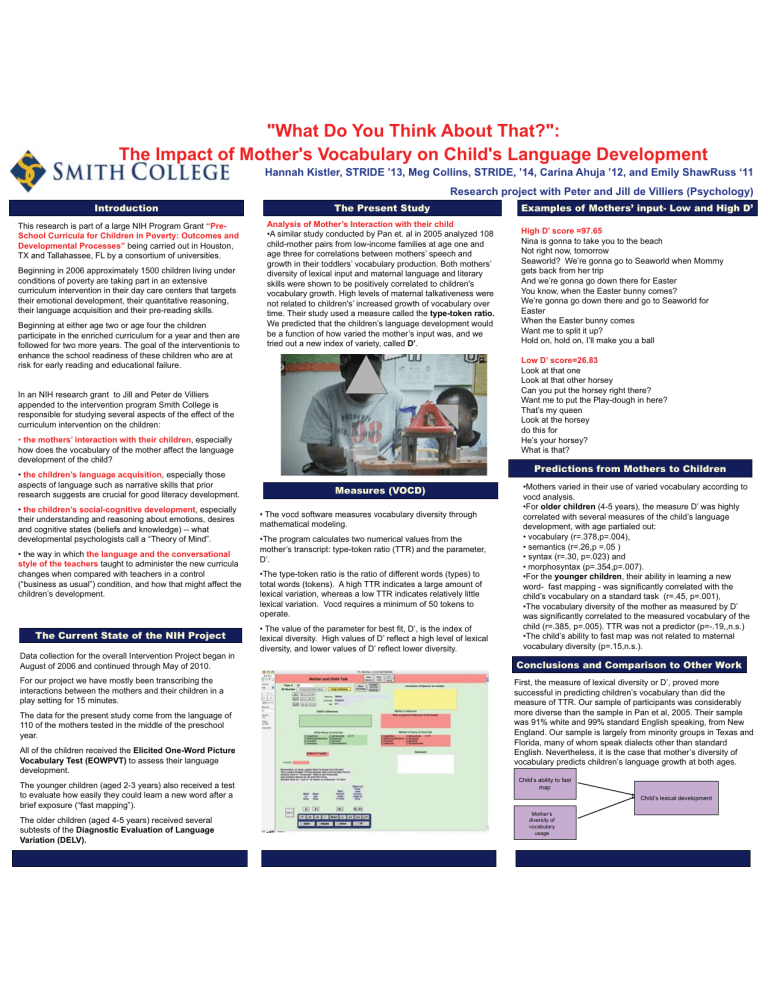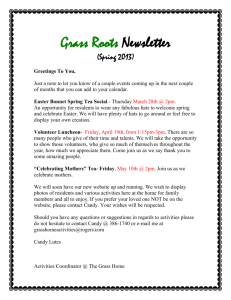"What Do You Think About That?":

"What Do You Think About That?":
The Impact of Mother's Vocabulary on Child's Language Development
Hannah Kistler, STRIDE ’13, Meg Collins, STRIDE, ’14, Carina Ahuja ’12, and Emily ShawRuss ‘11
Introduction
This research is part of a large NIH Program Grant “Pre-
School Curricula for Children in Poverty: Outcomes and
Developmental Processes” being carried out in Houston,
TX and Tallahassee, FL by a consortium of universities.
Beginning in 2006 approximately 1500 children living under conditions of poverty are taking part in an extensive curriculum intervention in their day care centers that targets their emotional development, their quantitative reasoning, their language acquisition and their pre-reading skills.
Beginning at either age two or age four the children participate in the enriched curriculum for a year and then are followed for two more years. The goal of the interventionis to enhance the school readiness of these children who are at risk for early reading and educational failure.
Research project with Peter and Jill de Villiers (Psychology)
The Present Study
Analysis of Mother’s Interaction with their child
• A similar study conducted by Pan et. al in 2005 analyzed 108 child-mother pairs from low-income families at age one and age three for correlations between mothers’ speech and growth in their toddlers’ vocabulary production. Both mothers’ diversity of lexical input and maternal language and literary skills were shown to be positively correlated to children's vocabulary growth. High levels of maternal talkativeness were not related to children's’ increased growth of vocabulary over time. Their study used a measure called the type-token ratio.
We predicted that the children’s language development would be a function of how varied the mother’s input was, and we tried out a new index of variety, called D’ .
Examples of Mothers’ input- Low and High D’
High D’ score =97.65
Nina is gonna to take you to the beach
Not right now, tomorrow
Seaworld? We’re gonna go to Seaworld when Mommy gets back from her trip
And we’re gonna go down there for Easter
You know, when the Easter bunny comes?
We’re gonna go down there and go to Seaworld for
Easter
When the Easter bunny comes
Want me to split it up?
Hold on, hold on, I’ll make you a ball
In an NIH research grant to Jill and Peter de Villiers appended to the intervention program Smith College is responsible for studying several aspects of the effect of the curriculum intervention on the children:
• the mothers’ interaction with their children , especially how does the vocabulary of the mother affect the language development of the child?
• the children’s language acquisition , especially those aspects of language such as narrative skills that prior research suggests are crucial for good literacy development.
• the children’s social-cognitive development , especially their understanding and reasoning about emotions, desires and cognitive states (beliefs and knowledge) -- what developmental psychologists call a “Theory of Mind”.
• the way in which the language and the conversational style of the teachers taught to administer the new curricula changes when compared with teachers in a control
(“business as usual”) condition, and how that might affect the children’s development.
The Current State of the NIH Project
Measures (VOCD)
• The vocd software measures vocabulary diversity through mathematical modeling.
• The program calculates two numerical values from the mother’s transcript: type-token ratio (TTR) and the parameter,
D’.
• The type-token ratio is the ratio of different words (types) to total words (tokens). A high TTR indicates a large amount of lexical variation, whereas a low TTR indicates relatively little lexical variation. Vocd requires a minimum of 50 tokens to operate.
• The value of the parameter for best fit, D’, is the index of lexical diversity. High values of D’ reflect a high level of lexical diversity, and lower values of D’ reflect lower diversity.
Low D’ score=26.83
Look at that one
Look at that other horsey
Can you put the horsey right there?
Want me to put the Play-dough in here?
That’s my queen
Look at the horsey do this for
He’s your horsey?
What is that?
Predictions from Mothers to Children
• Mothers varied in their use of varied vocabulary according to vocd analysis.
• For older children (4-5 years), the measure D’ was highly correlated with several measures of the child’s language development, with age partialed out:
• vocabulary (r=.378,p=.004),
• semantics (r=.26,p =.05 )
• syntax (r=.30, p=.023) and
• morphosyntax (p=.354,p=.007).
• For the younger children , their ability in learning a new word- fast mapping - was significantly correlated with the child’s vocabulary on a standard task (r=.45, p=.001),
• The vocabulary diversity of the mother as measured by D’ was significantly correlated to the measured vocabulary of the child (r=.385, p=.005). TTR was not a predictor (p=-.19,,n.s.)
• The child’s ability to fast map was not related to maternal vocabulary diversity (p=.15,n.s.).
Data collection for the overall Intervention Project began in
August of 2006 and continued through May of 2010.
For our project we have mostly been transcribing the interactions between the mothers and their children in a play setting for 15 minutes.
The data for the present study come from the language of
110 of the mothers tested in the middle of the preschool year.
All of the children received the Elicited One-Word Picture
Vocabulary Test (EOWPVT) to assess their language development.
The younger children (aged 2-3 years) also received a test to evaluate how easily they could learn a new word after a brief exposure (“fast mapping”).
The older children (aged 4-5 years) received several subtests of the Diagnostic Evaluation of Language
Variation (DELV).
Conclusions and Comparison to Other Work
First, the measure of lexical diversity or D’, proved more successful in predicting children’s vocabulary than did the measure of TTR. Our sample of participants was considerably more diverse than the sample in Pan et al, 2005. Their sample was 91% white and 99% standard English speaking, from New
England. Our sample is largely from minority groups in Texas and
Florida, many of whom speak dialects other than standard
English. Nevertheless, it is the case that mother’s diversity of vocabulary predicts children’s language growth at both ages.
Child’s ability to fast map
Mother’s diversity of vocabulary usage
Child’s lexical development







